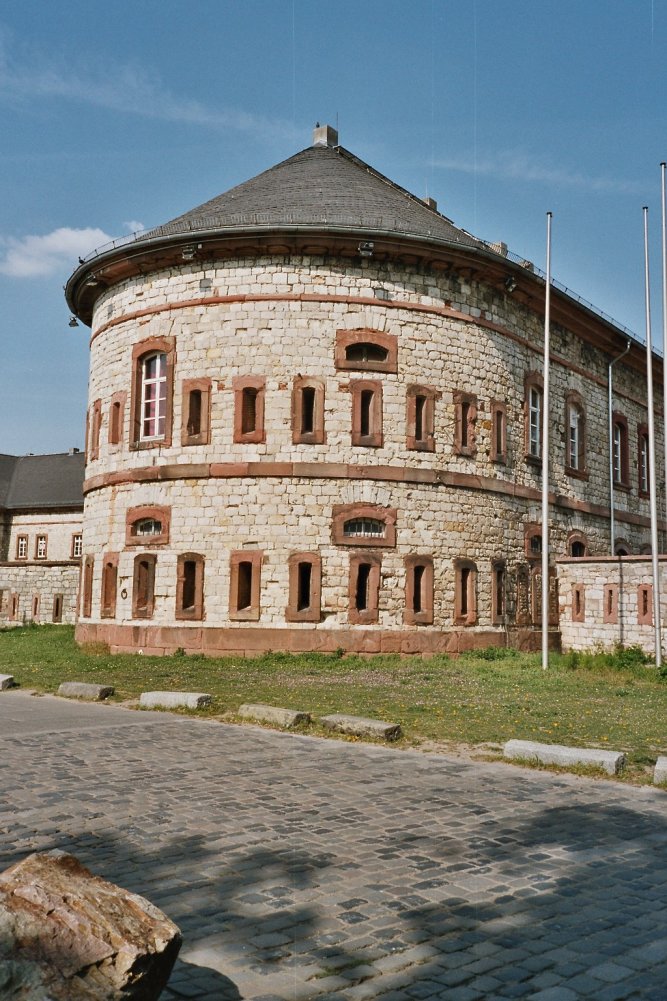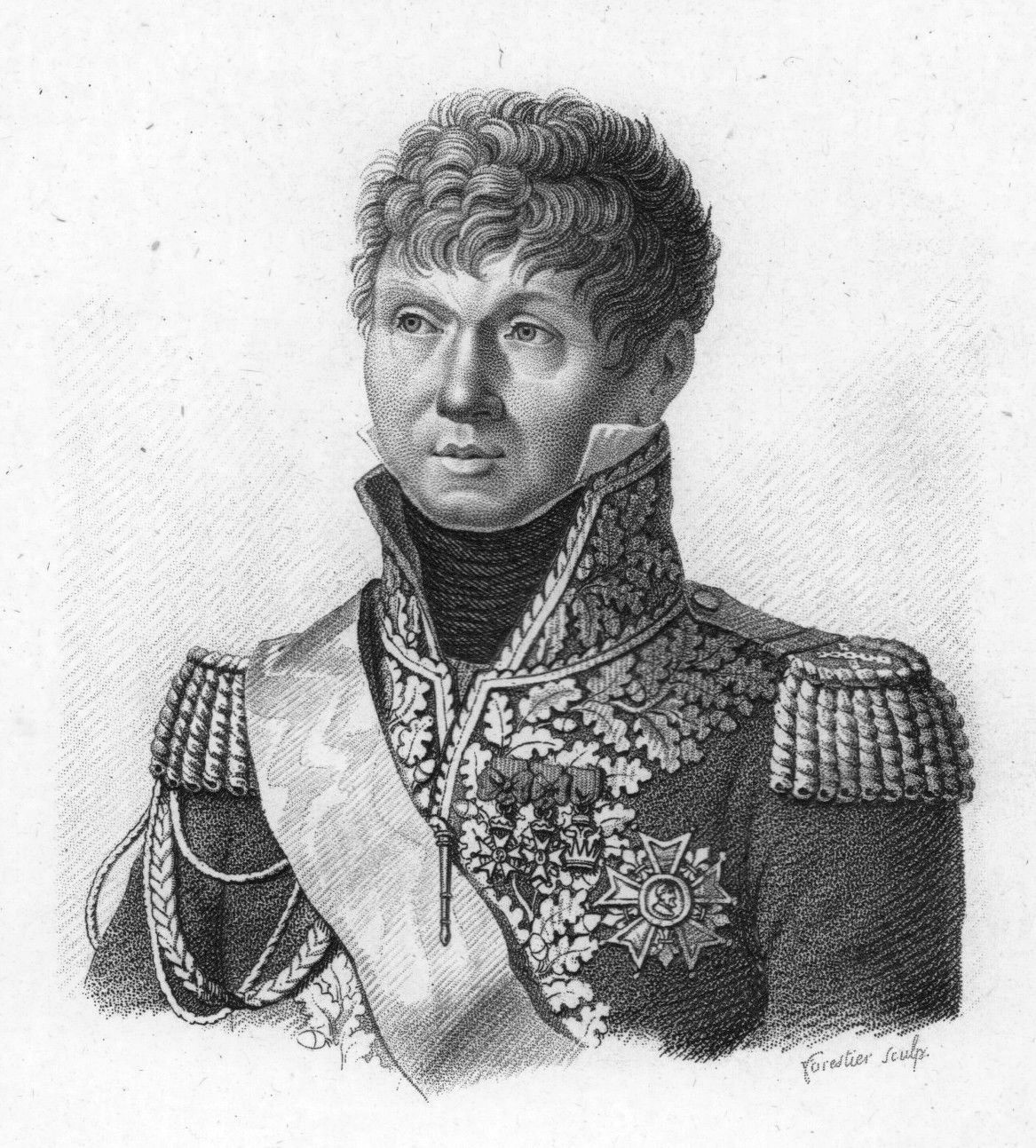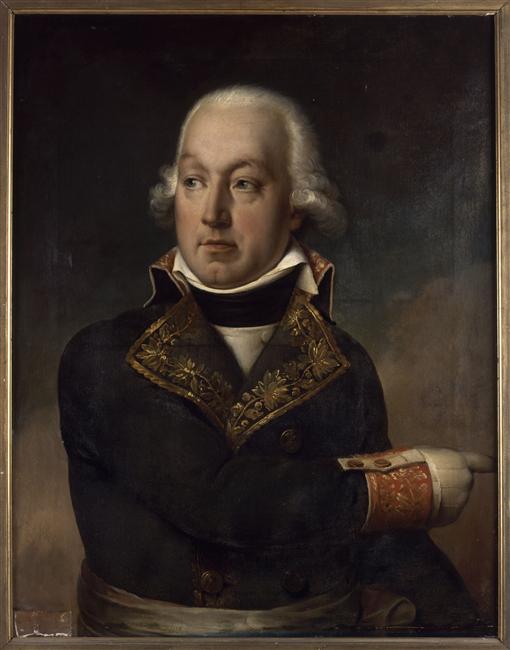|
Jacques-Antoine De Chambarlhac De Laubespin
Jean Jacques-Antoine Vital François de Chambarlhac (August 2, 1754 – February 23, 1826) was a French infantry commander during the French Revolutionary and Napoleonic Wars. Biography Before the French Revolution On May 1, 1769, Chambarlhac enlisted as a soldier in the Régiment d'Auvergne at age 15. On March 26, 1770, he became sub-lieutenant, and left the service four years later on January 1, before returning to service in 1791. French Revolutionary Wars Chambarlhac commanded the 1st Volunteer Battalion of Haute-Loire on June 21, 1792. He served with the Armée des Alpes, commanded by Kellermann, in 1792. In Prairial, year II (1795), he was chief of the 117th semi-brigade of the first formation. Later on 26 Ventôse, year IV, he was the brigadier chief of the 75th semi-brigade of the second formation. In year IV, as colonel, he fought with Napoleon Bonaparte in 1796–97. He fought in the battle of Arcole in Italy under Napoleon, and participated in the Siege o ... [...More Info...] [...Related Items...] OR: [Wikipedia] [Google] [Baidu] |
Les Estables
Les Estables (; oc, Los Estables) is a commune in the Haute-Loire department in south-central France. History A young geometer, who was doing survey work in the area for the Cassini maps, the first modern maps of France, was hacked to death by suspicious villagers in the 1740s. Population See also * Communes of the Haute-Loire department The following is a list of the 257 communes of the Haute-Loire department of France. The communes cooperate in the following intercommunalities (as of 2020):Communes of Haute-Loire {{HauteLoire-geo-stub ... [...More Info...] [...Related Items...] OR: [Wikipedia] [Google] [Baidu] |
Nobility Of The First French Empire
As Emperor of the French, Napoleon I created titles of nobility to institute a stable elite in the First French Empire, after the instability resulting from the French Revolution. Like many others, both before and since, Napoleon found that the ability to confer titles was also a useful tool of patronage which cost the state little treasure. In all, about 2,200 titles were created by Napoleon: * Princes and Dukes: **Princes of the Imperial family ***The Imperial Prince (Napoleon's son, Napoleon II) ***Princes of France (8 close family members) ** sovereign princes (3) ** duchies grand fiefs (20) ** victory princes (4) ** victory dukedoms (10) ** other dukedoms (3) * Counts (251) * Barons (1,516) * Knights (385) Napoleon also established a new knightly order in 1802, the Légion d'honneur, which is still in existence today. The Grand Dignitaries of the French Empire ranked, regardless of noble title, immediately behind the Princes of France. Creation Ennoblement started in 18 ... [...More Info...] [...Related Items...] OR: [Wikipedia] [Google] [Baidu] |
Fortress Of Mainz
The Fortress of Mainz was a fortressed garrison town between 1620 and 1918. At the end of the Napoleonic Wars, under the term of the 1815 Peace of Paris, the control of Mainz passed to the German Confederation and became part of a chain of strategic fortresses which protected the Confederation. With the dissolution of the Confederation and the Austro-Prussian War, control of the fortress first passed to Prussia, and, after the 1871 Unification of Germany, to the German Empire. 1839 In 1839 an article on Mainz in ''The Penny Cyclopædia'' stated that Mainz was one of the strongest fortresses in Europe, and a chief bulwark of Germany against France. At the Congress of Vienna, Mainz was assigned to the Louis, Grand-Duke of Hesse-Darmstadt, but it was decided that, as a fortress, it should belong to the German Confederation, with a garrison of Austrian, Prussian, and Hessian troops. This garrison in time of peace consisted of 6,000 men. The military governor, who retained his post ... [...More Info...] [...Related Items...] OR: [Wikipedia] [Google] [Baidu] |
Claude-Victor Perrin
Claude-Victor Perrin, 1st Duke of Belluno (7 December 1764 – 1 March 1841) was a French soldier and military commander who served during both the French Revolutionary Wars and the Napoleonic Wars. He was made a Marshal of the Empire in 1807 by Emperor Napoleon I. Life He was born at Lamarche in the Vosges in 1764, son of Charles Perrin and wife Marie Anne Floriot, paternal grandson of Charles Perrin and wife Gabrielle Guerin, born in 1696, and great-grandson of Pierre Perrin and wife Anne Louvière. At the age of 17 he enlisted in the artillery regiment in Grenoble as a private soldier, and after ten years' service he applied for and received his discharge because of his disgust at the manners revolutionary army and settled at Valence. Soon afterwards he joined the local volunteers, and distinguishing himself in the war on the Alpine frontier, in less than a year he had risen to the command of a battalion. In Drôme, Valence, on 16 May 1791 he married Jeanne Josephine ... [...More Info...] [...Related Items...] OR: [Wikipedia] [Google] [Baidu] |
François Joseph Lefebvre
François Joseph Lefebvre ( , ; 25 October 1755 – 14 September 1820), Duc de Dantzig, was a French military commander during the Revolutionary and Napoleonic Wars and one of the original eighteen Marshals of the Empire created by Napoleon. Early life Lefebvre was from Rouffach, Alsace, the son of a hussar. He enlisted in the French Army at the age of 17 and like his close friend, Michel Ordener, he embraced the French Revolution. In 1783 he married Cathérine Hübscher, with whom he had 14 children, although all predeceased him (his last son died in battle in 1812). Revolutionary Wars In 1789, Lefebvre was a sergeant in the Gardes Françaises. After its disbandment, he enlisted in the National Guard, where he received wounds protecting the Royal Family from an angry mob, after which he joined the revolution. Promoted to brigadier general in 1793, he took part in the Battle of Fleurus (24 June 1794). After General Louis Lazare Hoche's death he commanded the Army of Sambre-e ... [...More Info...] [...Related Items...] OR: [Wikipedia] [Google] [Baidu] |
Pluviôse
Pluviôse (; also ''Pluviose'') was the fifth month in the French Republican Calendar. The month was named after the Latin word ''pluviosus'', which means ''rainy''. Pluviôse was the second month of the winter quarter (''mois d'hiver''), starting between the 20th and 22 January, and ending between the 18th and 20 February. It follows the Nivôse and precedes the Ventôse. On October 24, 1793 Fabre d'Églantine suggested new names for the French Republican Calendar and on the 24th November the National Convention accepted the names with minor changes. It was decided to omit the circumflex (''accent circonflexe'') in the names of the winter months, so the month was named ''Pluviose'' instead of ''Pluviôse''. However, in historiography Historiography is the study of the methods of historians in developing history as an academic discipline, and by extension is any body of historical work on a particular subject. The historiography of a specific topic covers how historians ... [...More Info...] [...Related Items...] OR: [Wikipedia] [Google] [Baidu] |
Chouannerie
The Chouannerie (from the Chouan brothers, two of its leaders) was a royalist uprising or counter-revolution in twelve of the western ''départements'' of France, particularly in the provinces of Brittany and Maine, against the First Republic during the French Revolution. It played out in three phases and lasted from spring 1794 to 1800.Albert Soboul (dir.), ''Dictionnaire historique de la Révolution française'', Quadrige/PUF, 1989, p. 217, "Chouans/Chouannerie" entry by Roger Dupu.] The uprising was provoked principally by the Civil Constitution of the Clergy (1790) and the mass conscription, or '' levée en masse'' (1793), which was decided by the National Convention. A first attempt at staging an uprising was carried out by the ''Association bretonne'' to defend the French monarchy and reinstate the specific laws and customs of Brittany, which had been repealed in 1789. The first confrontations broke out in 1792 and developed in stages into a peasant revolt, guerrilla ... [...More Info...] [...Related Items...] OR: [Wikipedia] [Google] [Baidu] |
Barthélemy Louis Joseph Schérer
Barthélemy Louis Joseph Schérer (December 18, 1747 – August 19, 1804), born in Delle, near Belfort, became a French general during the French Revolutionary Wars and on three occasions led armies in battle. Early career Schérer served in the Austrian army long before the Revolution, but defected to France in 1775. In 1780 Schérer became a major in an artillery regiment stationed in Strasbourg. He entered Dutch service in 1785 as a major in the ''Légion de Maillebois''. In 1790 he was released from Dutch service with the rank of lieutenant colonel. French Revolution He returned to France in 1791 and in 1792 was made a captain in the 82nd Infantry Regiment, serving as aide-de-camp to General Jean de Prez de Crassier at the Battle of Valmy. In 1793 he served as a senior aide-de-camp to general Alexandre de Beauharnais on the Rhine. In 1794, Schérer was promoted to the rank of ''général de division'' and commanded a division in the Army of the Sambre and Meuse, serving wit ... [...More Info...] [...Related Items...] OR: [Wikipedia] [Google] [Baidu] |
Napoleon Bonaparte
Napoleon Bonaparte ; it, Napoleone Bonaparte, ; co, Napulione Buonaparte. (born Napoleone Buonaparte; 15 August 1769 – 5 May 1821), later known by his regnal name Napoleon I, was a French military commander and political leader who rose to prominence during the French Revolution and led Military career of Napoleon Bonaparte, successful campaigns during the French Revolutionary Wars, Revolutionary Wars. He was the ''de facto'' leader of the First French Republic, French Republic as First Consul from 1799 to 1804, then Emperor of the French from 1804 until 1814 and again in Hundred Days, 1815. Napoleon's political and cultural legacy endures to this day, as a highly celebrated and controversial leader. He initiated many liberal reforms that have persisted in society, and is considered one of the greatest military commanders in history. His wars and campaigns are studied by militaries all over the world. Between three and six million civilians and soldiers Napoleonic Wa ... [...More Info...] [...Related Items...] OR: [Wikipedia] [Google] [Baidu] |
Ventôse
Ventôse (; also ''Ventose'') was the sixth month in the French Republican Calendar. The month was named after the Latin word ''ventosus'', which means ''windy''. Ventôse was the third month of the winter quarter (''mois d'hiver''). It started between 19 and 21 February. It ended between 20 and 21 March. It follows the Pluviôse and precedes the Germinal. New names for the calendar were suggested by Fabre d'Églantine on 24 October 1793 and on 24 November the National Convention accepted the names with minor changes. It was decided to omit the circumflex (''accent circonflexe'') in the names of the winter months, so the month was named ''Ventose'' instead of ''Ventôse''. Historiography Historiography is the study of the methods of historians in developing history as an academic discipline, and by extension is any body of historical work on a particular subject. The historiography of a specific topic covers how historians ha ... still prefers the spelling ''Ventôse'' ... [...More Info...] [...Related Items...] OR: [Wikipedia] [Google] [Baidu] |
Prairial
Prairial () was the ninth month in the French Republican Calendar. This month was named after the French word ''prairie'', which means ''meadow''. It was the name given to several ships. Prairial was the third month of the spring quarter (). It started May 20 or May 21. It ended June 18 or June 19. It follows the Floréal and precedes the Messidor. Day name table Like all FRC months, Prairial lasted 30 days and was divided into three 10-day weeks called ''décades'' (decades). Every day had the name of an agricultural plant, except the 5th (Quintidi) and 10th day (Decadi) of every decade, which had the name of a domestic animal (Quintidi) or an agricultural tool (Decadi). Conversion table See also *Revolt of 1 Prairial Year III The insurrection of 1 Prairial Year III was a popular revolt in Paris on 20 May 1795 against the policies of the Thermidorian Convention. It was the last and one of the most remarkable and stubborn popular revolts of the French Revolutio ... [...More Info...] [...Related Items...] OR: [Wikipedia] [Google] [Baidu] |



